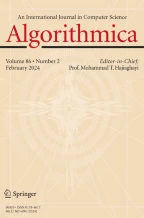Abstract
The diameter k-clustering problem is the problem of partitioning a finite subset of ℝd into k subsets called clusters such that the maximum diameter of the clusters is minimized. One early clustering algorithm that computes a hierarchy of approximate solutions to this problem (for all values of k) is the agglomerative clustering algorithm with the complete linkage strategy. For decades, this algorithm has been widely used by practitioners. However, it is not well studied theoretically. In this paper, we analyze the agglomerative complete linkage clustering algorithm. Assuming that the dimension d is a constant, we show that for any k the solution computed by this algorithm is an O(logk)-approximation to the diameter k-clustering problem. Our analysis does not only hold for the Euclidean distance but for any metric that is based on a norm. Furthermore, we analyze the closely related k-center and discrete k-center problem. For the corresponding agglomerative algorithms, we deduce an approximation factor of O(logk) as well.
Similar content being viewed by others
References
Bādoiu, M., Har-Peled, S., Indyk, P.: Approximate clustering via core-sets. In: Proceedings of the Thiry-Fourth Annual ACM Symposium on Theory of Computing, STOC’02, pp. 250–257. ACM, New York (2002)
Broder, A.Z., Glassman, S.C., Manasse, M.S., Zweig, G.: Syntactic clustering of the web. Comput. Netw. ISDN Syst. 29(8–13), 1157–1166 (1997). Papers from the Sixth International World Wide Web Conference
Charikar, M., Chekuri, C., Feder, T., Motwani, R.: Incremental clustering and dynamic information retrieval. In: Proceedings of the Twenty-Ninth Annual ACM Symposium on Theory of Computing, STOC’97, pp. 626–635. ACM, New York (1997)
Dasgupta, S., Long, P.M.: Performance guarantees for hierarchical clustering. J. Comput. Syst. Sci. 70(4), 555–569 (2005). Special Issue on COLT 2002
Eisen, M.B., Spellman, P.T., Brown, P.O., Botstein, D.: Cluster analysis and display of genome-wide expression patterns. Proc. Natl. Acad. Sci. 95(25), 14863–14868 (1998)
Feder, T., Greene, D.: Optimal algorithms for approximate clustering. In: Proceedings of the Twentieth Annual ACM Symposium on Theory of Computing, STOC’88, pp. 434–444. ACM, New York (1988)
Florek, K., Lukaszewicz, J., Perkal, J., Steinhaus, H., Zubrzycki, S.: Sur la liaison et la division des points d’un ensemble fini. Colloq. Math. 2, 282–285 (1951)
Fréchet, M.: Les dimensions d’un ensemble abstrait. Math. Ann. 68(2), 145–168 (1910)
Gonzalez, T.F.: Clustering to minimize the maximum intercluster distance. Theor. Comput. Sci. 38(0), 293–306 (1985)
Johnson, W.B., Joram, L.: Extensions of Lipschitz mappings into a Hilbert space. In: Conference in Modern Analysis and Probability. Contemporary Mathematics, vol. 26, pp. 189–206. Am. Math. Soc., Providence (1984)
Lee, K., Kim, J., Hoon Kwon, K., Han, Y., Kim, S.: DDoS attack detection method using cluster analysis. Expert Syst. Appl. 34(3), 1659–1665 (2008)
McQuitty, L.L.: Elementary linkage analysis for isolating orthogonal and oblique types and typal relevancies. Educ. Psychol. Meas. 17, 207–209 (1957)
Naszódi, M.: Covering a set with homothets of a convex body. Positivity 14, 69–74 (2010)
Pereira, F., Tishby, N., Lee, L.: Distributional clustering of English words. In: Proceedings of the 31st Annual Meeting on Association for Computational Linguistics, ACL’93, pp. 183–190. Association for Computational Linguistics, Stroudsburg (1993)
Sneath, P.H.A., Sokal, R.R.: Numerical Taxonomy: the Principles and Practice of Numerical Classification. Freeman, New York (1973)
Webster, R.: Convexity. Oxford Science Publications. Oxford University Press, London (1994)
Author information
Authors and Affiliations
Corresponding author
Additional information
A preliminary version of this article appeared in Proceedings of the 28th International Symposium on Theoretical Aspects of Computer Science (STACS’11), March 2011, pp. 308–319.
Work was done while M.R. Ackermann was at Department of Computer Science, University of Paderborn, Germany.
For all four authors this research was supported by the German Research Foundation (DFG), grants BL 314/6-2 and SO 514/4-2.
Rights and permissions
About this article
Cite this article
Ackermann, M.R., Blömer, J., Kuntze, D. et al. Analysis of Agglomerative Clustering. Algorithmica 69, 184–215 (2014). https://doi.org/10.1007/s00453-012-9717-4
Received:
Accepted:
Published:
Issue Date:
DOI: https://doi.org/10.1007/s00453-012-9717-4
